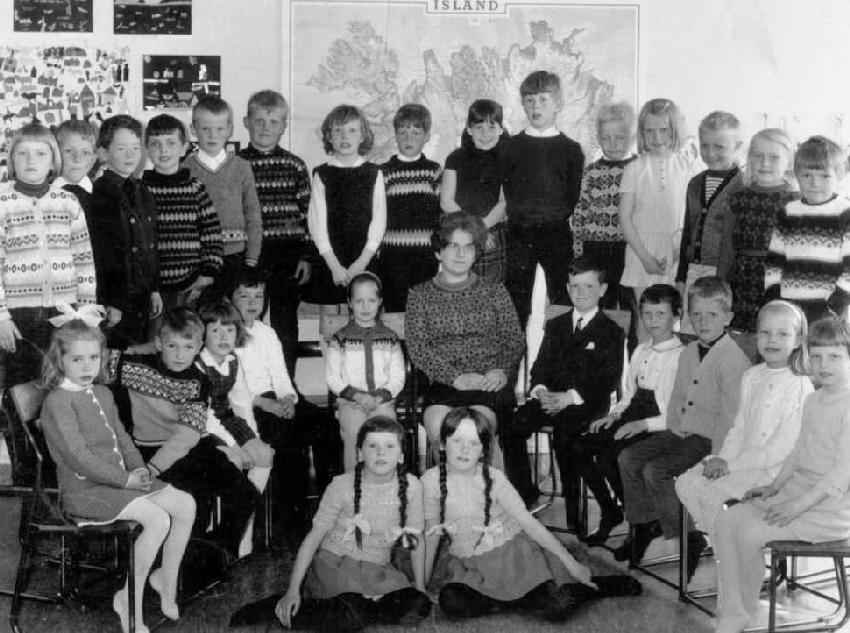
Icelandic Education

Figure 1.--Here we see children in an Icelsandic ublic primary sdchool. They look to be about 8 years old. This class portrait was taken during the 1966-67 school year. The children don't wear any uniform, but sweaters are very popular. Note that the children take off their shoes at school. There are very few private schools in Iceland.
|
|
Education in Iceland is similar to the school trends prevalent in Scandinavia. The ethos of the Icelandic educational system was once described as "School for each and everyone" designed to preparing student for life and work in a modern democratic society. The schools seek to promote independent thinking and personal development without any bias relsated to gender, scocial class, religion, handicaps and background. Optional plsay schools are available for younger children. The formal school program begins at age 6 and is divided into three major levels: primary schools, lower secondary schools, and upper secondary schools. Attendance is compulsory in primary and lower secondary schools (grades 1-10) through age 16 years. The basic curriculum includes: maths, languages, history, and religion. In the lower secondary school there are options with include handicrafts, baking, painting, singing, physical education, swimming, and story-telling. When a student finishes his compulsory basic education at age 16, he has a range of options to choose from.
There are four types of upper secondaty schools--framhaldsskóli meaning “continued school”.
First, industrial-vocational schools offer programs in trades, including electronics, information technology, Note that the vocational skills include both traditionally male and female occupsations. carpentry, dressmaking, hairdressing, etc.
Second, specialised vocational schools offering programs in specific trades and careers This includes clerical schools offer preparation for office jobs, including clerks, tellers etc.
Third, comprehensive schools offer a mixed program. They have a program including both academics and industrial-vocational indstruction. There are also specialised vocational programs. This includes special music schools which offer instruction in singing and musical instruments.
Fourth, academic schools offer preparation for university education.
Upper secondary education or , follows lower secondary education. These schools are also known as gymnasia.
This is a 4-year program ending with matriculation exams.
The age range of the upper secondary schools compare to the last 2 years of high school sand the first two years of college in the American system. Academically it is a little more dfficult to assess.
Most Icelandic children attend public school. There are very few private schools. An Icelandic student tells us, "We in Iceland don´t wear school uniforms."
HBC-SU

Related Chronolgy Pages in the Boys' Historical Web Site
[Main Chronology Page]
[The 1880s]
[The 1930s]
[The 1940s]
[The 1950s]
[The 1960s]
[The 1970s]
[The 1980s]
Related Style Pages in the Boys' Historical Web Site
[Smocks]
[Berets]
[Long pants suits]
[Shortpants suits]
[Socks]
[Eton suits]
[Jacket and trousers]
[Blazer]
[School sandals]
Navigate the Boys' Historical Clothing School Uniform Pages
[Return to the Main European school uniform page]
[Return to the Main country school uniform page]
[Denmark]
[Finland]
[]
[Norway]
[Scotland]
[Sweden]
Navigate the Boys' Historical Clothing Web Page
[Return to the Maun Algerian page]
[Introduction]
[Activities]
[Biographies]
[Chronology]
[Clothing styles]
[Countries]
[Bibliographies]
[Contributions]
[FAQs]
[Glossaries]
[Images]
[Links]
[Registration]
[Tools]
[Boys' Clothing Home]
Created: 7:26 AM 8/4/2009
Last updated: 7:26 AM 8/4/2009



